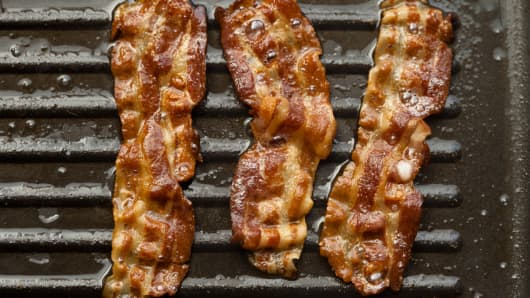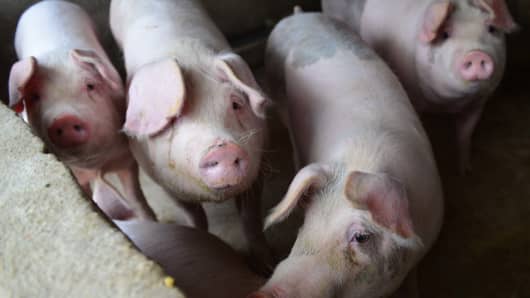- With African swine fever ravaging China’s hog industry, U.S. experts are expecting pork prices to go higher and likely stay elevated well into 2020.
- At least 129 cases of African swine fever have been reported in China since the first case was confirmed last August, and there have also been cases in Vietnam and other parts of Asia.
- “If I really like bacon, I’d be kind of stocking up,” says Steve Meyer, an industry economist with Kerns & Associates in Iowa.
- Some analysts say pork bellies, used to make bacon, could jump more than 40% and still show upside potential into 2020.

zeljkosantrac | iStock | Getty Images
With African swine fever ravaging China’s hog industry, U.S. experts are expecting pork prices to go higher and likely stay elevated well into 2020.
“If I really like bacon, I’d be kind of stocking up,” said Steve Meyer, an industry economist with Kerns & Associates in Iowa. “I’ve got about 12 pounds already in the freezer.”
At least 129 cases of African swine fever have been reported in China since the first case was confirmed last August. The incurable disease also has spread to other parts of Asia, including Vietnam.
“African swine fever in China could result in an extended period of elevated pork pricing in the U.S.,” wrote J.P. Morgan analyst Thomas Palmer in a research note last week. He said there’s still no containment of the swine virus, and the replacement of the herd in China is likely to take “a minimum of 20 months,” meaning “elevated demand for non-domestic pork will continue into 2020, at the least.”
A jump in wholesale pork and bacon prices could potentially impact profit margins for restaurants serving up BLTs, bacon cheeseburgers and pork belly sandwiches. As for American consumers, experts say supermarkets are likely to absorb some of the price increases in the short run for competitive reasons.
“When you have a bacon cheeseburger, if bacon price doubles, you might have another 30 to 40 cents on that sandwich,” said David Maloni, executive vice president of analytics for ArrowStream, a Chicago commodity researcher for the restaurant industry.
And restaurants are closely watching the price of pork bellies these days because bellies are used to make one of America’s favorite foods: bacon.
Maloni forecasts “belly prices may rise more than 40% from yesterday’s close before they seasonally peak later this year.” Also, he said there’s a chance they “could move even higher in 2020.”
Restaurant chains, particularly those in the fast-food sector, typically use hedging or forward contracting to mitigate any price spikes in meats, including bacon. Pork belly futures no longer trade on the Chicago market, but the lean hog futures are used by some companies to hedge risk on bacon.
.1556730851283.png)
According to Maloni, there’s been a gradual increase in demand for bacon to the point where the “running total of pork-belly disappearance” is tracking up 3.9% on a year-over-year basis, or the best growth since the summer of 2017.
He said domestic trends, when combined with the possibility of strong pork carcass exports to China, appear to show that pork belly supplies could be much tighter later this year and into 2020. He also believes the situation in China will have consequences for the poultry market, too.
On Wednesday, Chicago-traded June lean hogs rallied 3.4%. The most-active lean hogs contract has risen more than 60% since the start of March, although it still is below recent highs.
“We’re firmer today because the market got deeply oversold, technically,” said Don Roose, president of Iowa broker U.S. Commodities. “There’s also anticipation that Thursday’s weekly export sales report will show pork sales to China.”
The U.S.-China trading war has included retaliatory tariffs Beijing slapped on American pork, resulting in the product having a total import tax exceeding 60%. Other world pork suppliers have pushed to increase trade with Beijing, but there are signs China is starting to resume major U.S. pork purchases.

Visual China Group | Getty Images
Pigs raised by farmers are seen at Linquan county on December 5, 2018 in Fuyang, Anhui Province of China. A total of 81 cases of the African swine fever had been reported in 21 provincial regions in China by Monday, according to Xinhua.
“We’ve got some Chinese buyers that have been talking to U.S. packers,” said Meyer. “In the short run, the Chinese are going to take some more and drive our domestic prices higher. But in the long run, we will increase output to the degree we can do so responsibly, and we’ll supply what the world wants to buy.”
Beijing hasn’t divulged the exact number of hogs lost to swine fever, but Rabobank estimates up to 200 million animals could be affectedand production could decline by 30%. That compares with about 75 million hogs and pigs in the total U.S. inventory.
“In China, what we’ve seen over the winter was producers that had pigs near market weight hurry those to market before they got sick,” said Meyer. “There’s a ‘let’s beat this thing’ mentality in the early days of this. That will maintain pork supplies in the short run.”
China is believed to have a large reserve of pork supplies and significant supplies in cold storage. As pork supplies shrink, China may need to rely more on imported proteins, including poultry and beef.
Then again, while pork is a staple meat in the world’s most populous nation, the swine fever appears to have softened demand for the protein by Chinese consumers. But experts say the swine fever doesn’t pose a risk to humans.
“You’re going to see some negative impacts on demand,” said Meyer. “We think you’re seeing some of that over there. But eventually they will realize that no people are getting sick and nobody’s dying of this.”
— Graphics by CNBC’s John Schoen
[Disclaimer]










